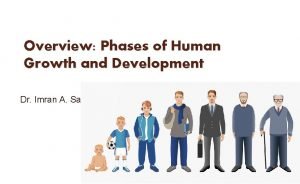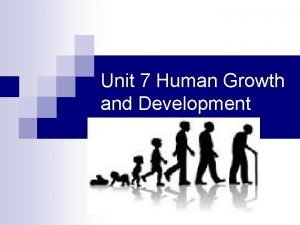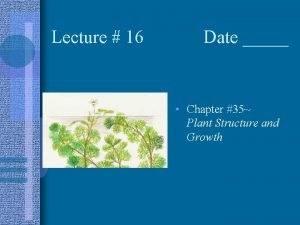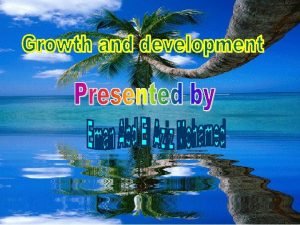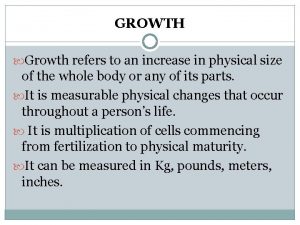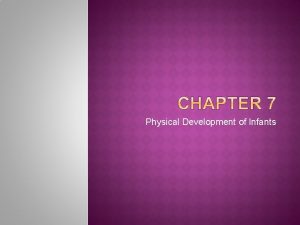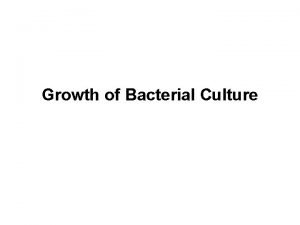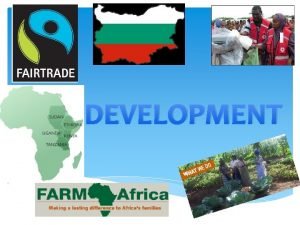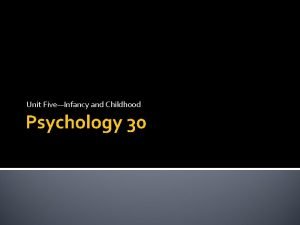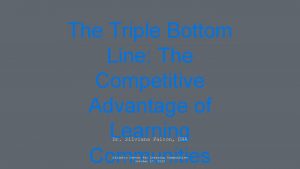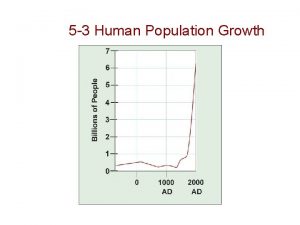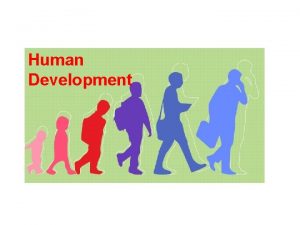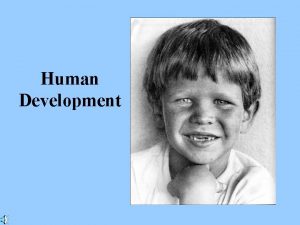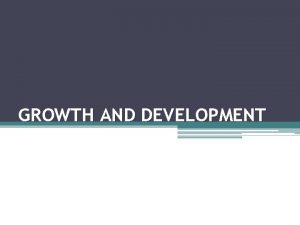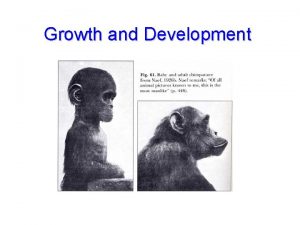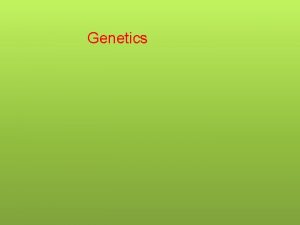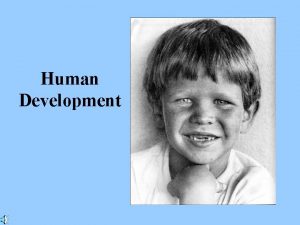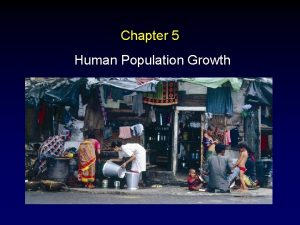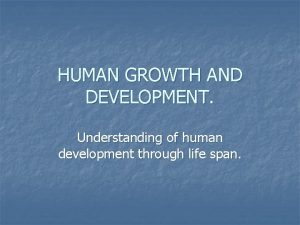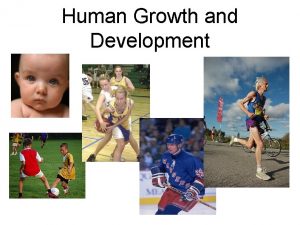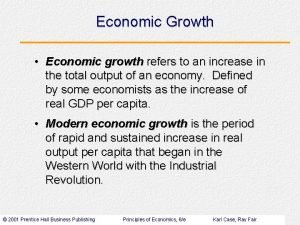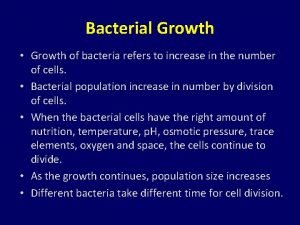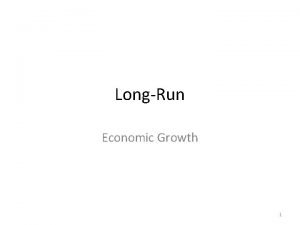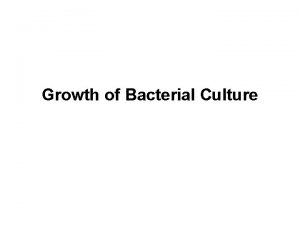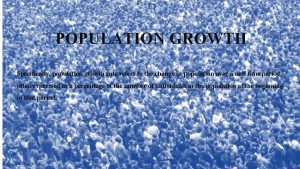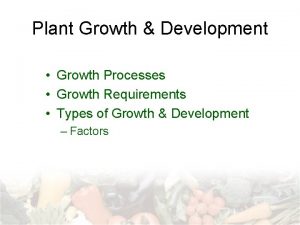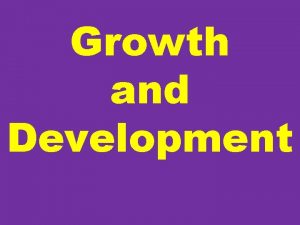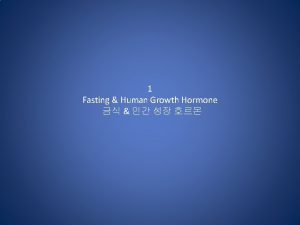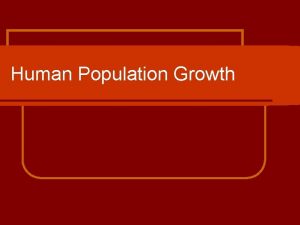HUMAN DEVELOPMENT CHAPTER 4 GROWTH Refers to an
































- Slides: 32

HUMAN DEVELOPMENT CHAPTER 4

GROWTH ØRefers to an increase in the size of the body parts or of the organism as a whole. ØIt can be measured or quantified, e. g. , growth in height , weight, etc.

DEVELOPMENT ØIs a process by which an individual grows and changes throughout the life cycle. ØThese changes have a direction and hold definite relationship with what precedes it and therefore will determine what will come after. ØAll changes which occur as a part of development are not of the same kind. ØThey are not temporary. ØIt involves changes-both growth and decline (as in old age).

MATURATION Ø Refers to the changes that follow an orderly sequence and are largely dictated by the genetic blueprint which produces commonalities in our growth and development. For e. g. , most children can sit without support by 7 months of age, stand with support by 8 months and walk by one year. Ø If the infant is maturationally not ready, special efforts to accelerate these behaviours do not help.

EVOLUTION Ø It refers to species specific changes. Ø Proceeds at a very slow pace, about millions of years. E. g. , natural selection

MEANING OF DEVELOPMENT Development is the pattern of: • Progressive • Orderly & • Predictable changes These changes begin at conception and continue throughout life We not only change physically but also in the way we think, use language and develop social relationships.

INFLUENCES ON DEVELOPMENT It is influenced by an interplay of • Biological • Cognitive • Socio-emotional processes

• BIOLOGICAL PROCESSES Development due to genes inherited from parents, such as height and weight, brain , heart, lungs development, etc. show the role of biological processes. • COGNITIVE PROCESSES: They relate to the mental activities associated with the processes of knowing and experiencing, such as thought, perception, attention, problem solving, etc.

• SOCIO-EMOTIONAL PROCESSES: They refer to the changes in an individual’s interactions with other people, changes in emotions and in personality. It is important to remember that these three processes are interwoven. They keep on influencing the changes in the development of the individual as a whole throughout the human life-span


LIFE-SPAN PERSPECTIVE ON DEVELOPMENT The term development means a progressive series of changes that occur as a result of maturation and experience It includes the following assumptions: 1. It is lifelong, i. e. , it takes place across all age groups starting from conception to old age. It includes both gains and losses (changes in one aspect goes with changes in others). 2. The various processes of human development, i. e. , biological, cognitive, and socio-emotional are interwoven in the development of a person througout the life span.

3. It is multi-directional: some components of a dimension may increase while others may decrease. E. g. , with age you become wiser with your experiences but your performance is likely to decrease. 4. It is highly plastic: i. e. , within a person, modifiability is found in psychological development. E. g. , skills and abilities can be improved or developed through-out the life span. It varies among the various individuals.

5. It is influenced by historical conditions. E. g. , the experiences of 20 year olds who lived during the freedom struggle would be very different from the 20 year old of today. The career orientations of school students would be very different today from a students who was in school 50 years ago. 6. It’s a concern of a number of disciplines: different disciplines like Psychology, Sociology, Anthropology, and Neuro-sciences study human development. . each trying to provide answers to development throughout the lifespan.

7. An individual responds and acts in a particular context. E. g. , the life events in everyone’s life are not the same such as death of a parent, accident, earthquake, etc affect the course of one’s life as also the positive influences such as winning an award or getting a good job.

FACTORS INFLUENCING DEVELOPMENT • GENOTYPE: the actual genetic material or a person’s genetic heritage is known as genotype. All of this genetic material is not apparent or distinctly identifiable in our observable characteristics. • PHENOTYPE: it is the way an individual’s genotype is expressed in observable and measurable characteristics. It includes physical traits such as height, weight, eye and skin colour, psychological characteristics such as intelligence, creativity and personality.

• These observable characteristics of an individual are the result of the interaction between the person’s inherited traits and the environment. • It is the genetic code which pre-disposes a child to develop in a particular way. • Genes provide a distinct blueprint and time-table for the development of an individual • Genes do not exist in isolation and development occurs within the context of an individual’s environment. This is why each one of us is unique

• Genes set the limit and within that limit the environment influences development. e. g. , a child has a genotype which predisposes him/her to be introverted, in an environment that promotes social interaction and extroversion. The influence of such an environment may make the child a little extroverted. An individual with “short” height genes, even if he/she is in a very good nutritional environment, will never be able to be taller than average.

• Parents not only provide the genes for the child’s development but also play an important role in determining the type of environment their children will encounter. • Sandra Scarr(1992) believes that the environment parents provide for their children depends to some extent on their own genetic predisposition. E. g. , if parents are intelligent and are good readers they would provide their children with books to read, with the likely outcome that their children would become good readers who enjoy reading. A child’s own genotype(what he/she has inherited) such as being cooperative and attentive is likely to result in teachers and parents giving more pleasant response as compared to children who are not cooperative or attentive. Children themselves choose certain environments based on their genotype. For e. g. , because of their genotype, children may perform well in music or sports and they will seek and spend more time in such environments

CONTEXT OF DEVELOPMENT • It does not take place in a vacuum. • It is always embedded in a particular socio-cultural context. • The environment can change or alter during any time of the individual’s life span. • Transition during one’s lifetime such as entering school, becoming an adolescent, finding jobs, marrying, having children, retirement, etc. All are joint functions of the biological changes and the changes in one’s environment.

URIE BRONFENBRENNER Contextual view of development. Emphasises the role of environmental factors in the development of an individual q. Microsystem q. Mesosystem q. Exosystem q. Macrosystem q. Chronosystem

MICROSYSTEM: it is the immediate environment/ setting in which the individual lives. In these settings the child directly interacts with social agents-the family, peers, teachers and neighbourhood. MESOSYSTEM: consists of relations between these contexts. E. g. , how a child’s parents relate to teachers ot how the parents view the adolescent’s friends, etc. These experiences are likely to influence an individual’s relationships with others.

• EXOSYSTEM: it includes events in social settings where the child does not participate directly, but they influence the child’s experiences in the immediate context. E. g. , the transfer of father or mother may cause tension among the parents which might affect their interactions with the child or the general amenities available to the child like quality of schooling, libraries, medical care, means of entertainment etc

• MACROSYSTEM: includes the culture in which the individual lives. • CHRONOSYSTEM: involves events in the individual’s life course and socio-historical circumstances of the time, e. g. , separation of the parents or parent’s economic setback and their effect on the child


Bronfenbrenner’s Ecological Theory Bronfenbrenner’s theory focuses on the social contexts in which people live and the people who influence their development.

• Bronfenbrenner’s view is that a child’s development is significantly affected by the complex world that envelops him/her. Eg. , children in impoverished environments • Have unstimulating environment devoid of books, magazines, toys, etc. • Lack experiences such as visit to the library, museum, zoo, etc. • Have parents who are ineffective as role models. • Live in overcrowded and noisy surroundings. As a result of these conditions, children are at a disadvantage and have difficulties in learning.

DURGANAND SINHA(1977) ECOLOGICAL MODEL To understand the development of children in Indian context. Ecology of the child would be viewed in terms of two concentric layers: Upper and the most visible layers consist of home, school, peer groups and so on. Factors influencing development of the child in the visible upper layer are: 1. Home-overcrowding, space available for each member, toys, technological devices used, etc 2. Nature and quality of schooling-facilities to which the child is exposed. 3. Nature of interactions and activities undertaken with peer group from childhood onwards.

• These factors do not operate independently but constantly interact with each other. • Surrounding layers of the child’s ecology constantly influence the “upper layer” factors. • The influences are not clearly visible. They include: 1. General geographical environment- space and facilities for play and other activities available outside the home, general congestion of the locality and the density of population. 2. Institutional setting provided by caste, class and other factors 3. General amenities available: drinking water, electricity, means of entertainment, etc

The visible and surrounding layer factors • interact with one another and • may have different consequences for development in different people. • The ecological environment can change or alter during any time of the individual’s life span.

DEVELOPMENTAL STAGES • Development is described in terms of period /stages. You must have observed that people around you behave in different ways • The variation in their behaviour is partly because everyone is in a different stage of life • Human life proceeds through different stages. For e. g. , you are at present in the stage of adolescence and after a few years you will enter the stage of adulthood.

• Developmental stages are assumed to be temporary. • They are often characterised by a dominant feature or a leading characteristic, which gives each period its uniqueness. • Individuals vary with respect to time or rate of development from one stage to another. • Certain patterns of behaviour and certain skills are learned more easily and successfully during certain stages. • These accomplishments of a person become the social expectations of that stage of development. They are known as developmental tasks.

PRENATAL STAGE Key Features • The period from conception till birth is known as the prenatal period. • Typically, it lasts for about 40 weeks. • The genetic blueprint guides our development during the prenatal period and after birth. • Both genetic and environmental factors affect our development during different periods of prenatal stage.
 Infancy psychosocial development
Infancy psychosocial development Chapter 8 human needs and human development
Chapter 8 human needs and human development Chapter 8 human needs and human development
Chapter 8 human needs and human development Social changes in adulthood
Social changes in adulthood Theories on growth and development
Theories on growth and development Stages of human development
Stages of human development Most productive life stage
Most productive life stage Human growth and development
Human growth and development Human development index definition ap human geography
Human development index definition ap human geography Chapter 35 plant structure growth and development
Chapter 35 plant structure growth and development Primary growth and secondary growth in plants
Primary growth and secondary growth in plants Development refers to
Development refers to Growth refers to
Growth refers to Growth refers to
Growth refers to Growth refers to
Growth refers to Diauxic growth definition
Diauxic growth definition Plant growth definition
Plant growth definition Root hair structure
Root hair structure Growthchain
Growthchain Primary growth and secondary growth in plants
Primary growth and secondary growth in plants Geometric growth population
Geometric growth population Neoclassical growth theory vs. endogenous growth theory
Neoclassical growth theory vs. endogenous growth theory Difference between organic and inorganic growth
Difference between organic and inorganic growth Diversity and human needs and development
Diversity and human needs and development Ovulation animation
Ovulation animation It is generally refers to human movement
It is generally refers to human movement The term development refers to
The term development refers to Effects of human growth hormone
Effects of human growth hormone Bill cosby psychology
Bill cosby psychology Human growth
Human growth Slow growth cities ap human geography
Slow growth cities ap human geography Population growth concept map answers
Population growth concept map answers 5-3 human population growth
5-3 human population growth





